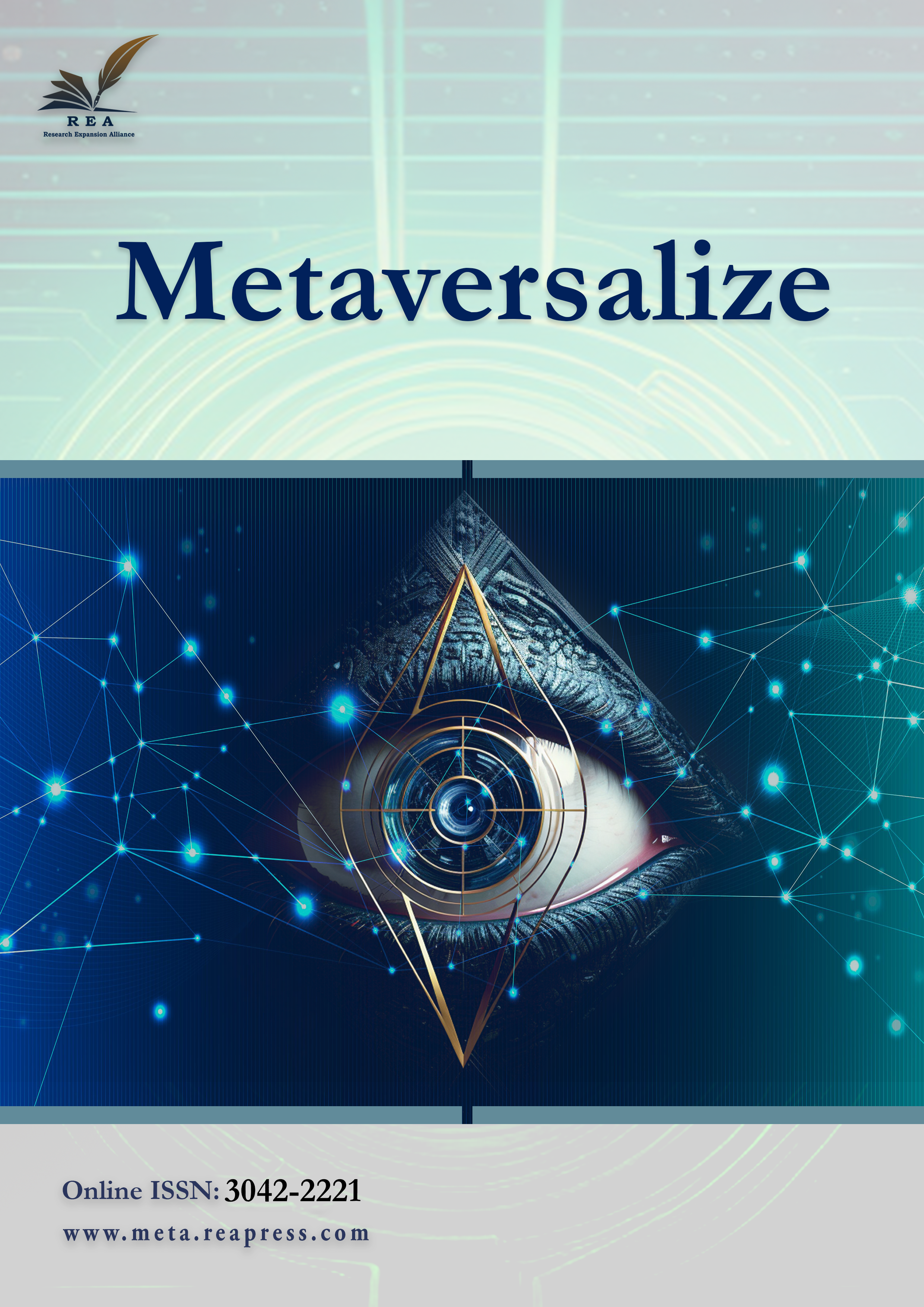Transforming user experience in the metaverse through edge technology
Abstract
The metaverse, an emerging virtual universe, allows real-time interactions and solid social links between humans, akin to the physical world. However, today's cloud-based metaverse infrastructure struggles to meet the metaverse's low latency and high bandwidth requirements. This is where edge computing steps in, moving processing closer to consumers and applications and overcoming these challenges. The metaverse, as a new distributed computing paradigm for computationally intensive tasks, can be offloaded to the network's edge. In this paper, we first outline the architecture of the metaverse and the driving technologies and underscore the pivotal role of edge computing in the digital infrastructure for realizing the metaverse. We then propose an edge computing-enabled metaverse, focusing on its performance in terms of rendering, latency, resource allocation, and communication. Finally, we delve into the challenges of implementing edge techniques, ensuring a comprehensive understanding of the topic.
Keywords:
Metaverse, Edge computing, Distributed computing, LatencyReferences
- [1] Wang, G., Badal, A., Jia, X., Maltz, J. S., Mueller, K., Myers, K. J., … & Zeng, R. (2022). Development of metaverse for intelligent healthcare. Nature machine intelligence, 4(11), 922–929. https://doi.org/10.1038/s42256-022-00549-6
- [2] Ali, S., Abdullah, Armand, T. P. T., Athar, A., Hussain, A., Ali, M., … & Kim, H. C. (2023). Metaverse in healthcare integrated with explainable AI and blockchain: Enabling immersiveness, ensuring trust, and providing patient data security. Sensors, 23(2), 565. https://doi.org/10.3390/s23020565
- [3] Hoang, D. T., Nguyen, D. N., Nguyen, C. T., Hossain, E., & Niyato, D. (2023). Metaverse communication and computing networks: Applications, technologies, and approaches. John Wiley & Sons. https://doi.org/10.1002/9781394160013
- [4] Kulkarni, S., Dwivedi, J. N., Pramanta, D., & Tanaka, Y. (2024). Edge computational intelligence for AI-enabled IoT systems. CRC Press. https://doi.org/10.1201/9781032650722
- [5] Kashyap, R. (2022). Machine learning, data mining for IoT-based systems. In Research anthology on machine learning techniques, methods, and applications (pp. 447–471). IGI Global. https://doi.org/10.4018/978-1-6684-6291-1.ch025
- [6] Wang, Y., & Zhao, J. (2022). A survey of mobile edge computing for the metaverse: Architectures, applications, and challenges. 2022 IEEE 8th international conference on collaboration and internet computing (CIC) (pp. 1–9). IEEE. https://doi.org/10.1109/CIC56439.2022.00011
- [7] Bavkar, D., Kashyap, R., & Khairnar, V. (2023). Deep hybrid model with trained weights for multimodal sarcasm detection. International conference on information, communication and computing technology (pp. 179–194). Singapore: Springer Nature Singapore. https://doi.org/10.1007/978-981-99-5166-6_13
- [8] Zhang, J., Chen, B., Zhao, Y., Cheng, X., & Hu, F. (2018). Data security and privacy-preserving in edge computing paradigm: Survey and open issues. IEEE access, 6, 18209–18237. https://doi.org/10.1109/ACCESS.2018.2820162
- [9] Ahsani, V., Rahimi, A., Letafati, M., & Khalaj, B. H. (2023). Unlocking metaverse-as-a-service the three pillars to watch: Privacy and security, edge computing, and blockchain. http://arxiv.org/abs/2301.01221
- [10] Lee, L. H., Braud, T., Zhou, P., Wang, L., Xu, D., Lin, Z., … & Hui, P. (2021). All one needs to know about metaverse: A complete survey on technological singularity, virtual ecosystem, and research agenda. http://arxiv.org/abs/2110.05352
- [11] Chang, L., Zhang, Z., Li, P., Xi, S., Guo, W., Shen, Y., ... & Wu, Y. (2022). 6G-enabled edge AI for metaverse: challenges, methods, and future research directions. Journal of communications and information networks, 7(2), 107–121. https://doi.org/10.23919/JCIN.2022.9815195
- [12] Xu, M., Ng, W. C., Lim, W. Y. B., Kang, J., Xiong, Z., Niyato, D., … & Miao, C. (2023). A full dive into realizing the edge-enabled metaverse: Visions, enabling technologies, and challenges. IEEE communications surveys and tutorials, 25(1), 656–700. https://doi.org/10.1109/COMST.2022.3221119
- [13] Manushri, S. K., Santhiya, J., Roobasri, A. E., Keshav Shanmukhanathan, E., & Sanjai, V. (2022). Metaverse-the future of virtual world. International journal of engineering technology and management sciences, 6(5), 779–783. https://doi.org/10.46647/ijetms.2022.v06i05.121
- [14] Zhu, H. Y., Hieu, N. Q., Hoang, D. T., Nguyen, D. N., & Lin, C. T. (2024). A human-centric metaverse enabled by brain-computer interface: A survey. IEEE communications surveys and tutorials, 1–1. https://doi.org/10.1109/COMST.2024.3387124
- [15] Cao, B., Wang, Z., Zhang, L., Feng, D., Peng, M., Zhang, L., & Han, Z. (2023). Blockchain systems, technologies, and applications: A methodology perspective. IEEE communications surveys and tutorials, 25(1), 353–385. https://doi.org/10.1109/COMST.2022.3204702
- [16] Alkhateeb, A., Jiang, S., & Charan, G. (2023). Real-time digital twins: Vision and research directions for 6G and beyond. IEEE communications magazine, 61(11), 128–134. https://doi.org/10.1109/MCOM.001.2200866
- [17] Dhillon, P. K. S., & Tinmaz, H. (2024). Immersive realities: A comprehensive guide from virtual reality to metaverse. Journal for the education of gifted young scientists, 12(1), 29–45. https://doi.org/10.17478/jegys.1406024
- [18] Azeem, W., Malik, A. A., & Yar, M. A. (2019). Internet of things: Architectural components, protocols and its implementation for ubiquitous environment. Lahore garrison university research journal of computer science and information technology, 3(3), 51–55. https://doi.org/10.54692/lgurjcsit.2019.030384
- [19] Taye, M. M. (2023). Understanding of machine learning with deep learning: architectures, workflow, applications and future directions. Computers, 12(5), 91. https://doi.org/10.3390/computers12050091
- [20] Zhang, W., Chen, J., Zhang, Y., & Raychaudhuri, D. (2017). Towards efficient edge cloud augmentation for virtual reality mmogs [presentation]. Proceedings of the second ACM/IEEE symposium on edge computing (pp. 1–14). https://doi.org/10.1145/3132211.3134463
- [21] Dhelim, S., Kechadi, T., Chen, L., Aung, N., Ning, H., & Atzori, L. (2022). Edge-enabled metaverse: The convergence of metaverse and mobile edge computing. TechRxiv. https://doi.org/10.36227/techrxiv.19606954.v1
- [22] Guo, F., Yu, F. R., Zhang, H., Ji, H., Leung, V. C. M., & Li, X. (2020). An adaptive wireless virtual reality framework in future wireless networks: A distributed learning approach. IEEE transactions on vehicular technology, 69(8), 8514–8528. https://doi.org/10.1109/TVT.2020.2995877
- [23] Park, J., & Bennis, M. (2018). URLLC-embb slicing to support VR multimodal perceptions over wireless cellular systems. Proceedings-IEEE global communications conference (GLOBECOM) (pp. 1–7). IEEE. https://doi.org/10.1109/GLOCOM.2018.8647208
- [24] Yang, W., Liew, Z. Q., Lim, W. Y. B., Xiong, Z., Niyato, D., Chi, X., … & Letaief, K. B. (2022). Semantic communication meets edge intelligence. IEEE wireless communications, 29(5), 28–35. https://doi.org/10.1109/MWC.004.2200050
- [25] Duan, H., Li, J., Fan, S., Lin, Z., Wu, X., & Cai, W. (2021). Metaverse for social good: a university campus prototype [presentation]. Proceedings of the 29th acm international conference on multimedia (pp. 153–161). https://doi.org/10.1145/3474085.3479238
- [26] Chen, Y., Zhang, N., Zhang, Y., Chen, X., Wu, W., & Shen, X. (2019). Energy efficient dynamic offloading in mobile edge computing for internet of things. IEEE transactions on cloud computing, 9(3), 1050–1060. https://doi.org/10.1109/TCC.2019.2898657
- [27] Sunyaev, A. (2020). Fog and edge computing. Internet computing: principles of distributed systems and emerging internet-based technologies, 237–264. https://doi.org/10.1007/978-3-030-34957-8
- [28] Beck, M. T., Werner, M., Feld, S., & Schimper, T. (2014). Mobile edge computing : A taxonomy [presentation]. Proc. of the sixth international conference on advances in future internet. (pp. 48–54). https://www.researchgate.net/publication/267448582_Mobile_Edge_Computing_A_Taxonomy
- [29] Lam, N. T. (2021). Developing a framework for detecting phishing URLs using machine learning. International journal of emerging technology and advanced engineering, 11(11), 61–67. https://doi.org/10.46338/IJETAE1121_08
- [30] Liu, X., Zheng, J., Zhang, M., Li, Y., Wang, R., & He, Y. (2024). Multi-user computation offloading and resource allocation algorithm in a vehicular edge network. Sensors, 24(7), 2205. https://doi.org/10.3390/s24072205
- [31] Saad, W., Bennis, M., & Chen, M. (2020). A vision of 6G wireless systems: Applications, trends, technologies, and open research problems. IEEE network, 34(3), 134–142. https://doi.org/10.1109/MNET.001.1900287
- [32] Quang Hieu, N., Nguyen, D. N., Hoang, D. T., & Dutkiewicz, E. (2022). When virtual reality meets rate splitting multiple access: A joint communication and computation approach. https://doi.org/10.48550/arXiv.2207.12114
- [33] Letaief, K. B., Chen, W., Shi, Y., Zhang, J., & Zhang, Y. J. A. (2019). The roadmap to 6G: AI empowered wireless networks. IEEE communications magazine, 57(8), 84–90. https://doi.org/10.1109/MCOM.2019.1900271
- [34] Mao, Y., Dizdar, O., Clerckx, B., Schober, R., Popovski, P., & Poor, H. V. (2022). Rate-splitting multiple access: Fundamentals, survey, and future research trends. IEEE communications surveys & tutorials, 24(4), 2073–2126. https://doi.org/10.1109/COMST.2022.3191937
- [35] You, X., Wang, C. X., Huang, J., Gao, X., Zhang, Z., Wang, M., … & Liang, Y. C. (2021). Towards 6G wireless communication networks: Vision, enabling technologies, and new paradigm shifts. Science china information sciences, 64(1), 1–74. https://doi.org/10.1007/s11432-020-2955-6
- [36] Tataria, H., Shafi, M., Molisch, A. F., Dohler, M., Sjoland, H., & Tufvesson, F. (2021). 6G wireless systems: Vision, requirements, challenges, insights, and opportunities. Proceedings of the IEEE, 109(7), 1166–1199. https://doi.org/10.1109/JPROC.2021.3061701
- [37] Jana, S., Molnar, D., Moshchuk, A., Dunn, A., Livshits, B., Wang, H. J., & Ofek, E. (2013). Enabling fine-grained permissions for augmented reality applications with recognizers [presentation]. Proceedings of the 22nd usenix security symposium (pp. 415–430). https://www.usenix.org/conference/usenixsecurity13/technical-sessions/presentation/jana
- [38] Shang, J., & Wu, J. (2019). Enabling secure voice input on augmented reality headsets using internal body voice. 2019 16th annual ieee international conference on sensing, communication, and networking (SECON) (pp. 1–9). IEEE. https://doi.org/10.1109/SAHCN.2019.8824980






